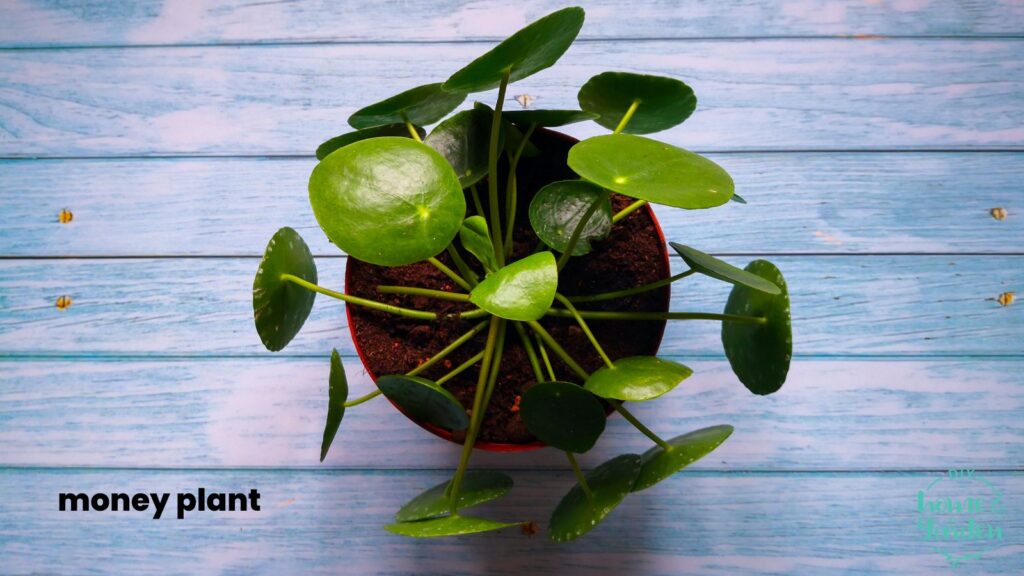This article will give you an overview of the Chinese money plant and discuss how to care for it properly. You will learn the following concepts:
- The best kind of growing medium for the money plant.
- How to take care of it.
- Watering needs.
- What growing problems you may encounter.
- If Chinese money plants are safe for your pets.
About the Chinese money plant
Pilea peperomioides (also called the Chinese money plant) is a very easy houseplant to grow. It requires well-draining soil and moderate watering. It also needs indirect sunlight for the best results.
Its colorful, circular leaves and distinctive shape have earned it many names. In fact, it takes its name from the coin-shaped glossy green leaves. In Chinese culture, it represents good luck, prosperity, and the promise of a more abundant life. It holds cultural significance and the name honors its importance in several Asian cultures.
Shopping for the supplies to plant a Chinese money plant?
This plant grows best in a well-draining potting medium–so be sure to pick up good soil. Ensure your container has drainage holes, as the Chinese Money Plant needs a little more water during warmer weather. You should also rotate the pot at least once a week to allow the soil to drain correctly. Moreover, it should be kept from too much water, leading to root rot. It also benefits from regular wiping down of the leaves and monthly fertilizing.
Suggestions for plant health
The best way to care for a Money Plant is to follow a few basic steps. First, make sure to water the plant regularly. This can be as often as once a week, but do not overwater. If you notice that the stems are losing vigor or flopping, you should water the plant again. Secondly, rotate the plant every week, avoiding direct exposure to light. Finally, fertilize your plant monthly.
Money plants like water, but they don’t do well with too much. Avoid overwatering this plant, as this will cause the roots to rot. It’s also good to mist the leaves to keep them moist. If you notice that your money plant’s leaves are becoming yellow, you’re likely overwatering it.
Problems that can occur with a Chinese money plant
One of the most common problems that money plants can have is over-watering. Over-watering will cause the plant to suffer from leaf drop, stunted growth, and yellowing leaves. To prevent this from happening, raise the pH level of the soil by adding lime to it.
To grow money plants, you should ensure the soil is well-drained. Plants should receive at least one inch of water per day. During the first few weeks, the soil should be moist but not too moist.
Chinese money plants don’t like extreme temperatures, so they need moderate moisture. They also don’t like soggy soil. You should water them once or twice a week, or more if you have a sunny location.
Is the Chinese money plant pet-safe (cats and dogs)?
I checked the scientific name Pilea peperomioides and the common name variations against the ASPCA’s Pet Poison Control guidance. The plant does not appear on the list of toxic or poisonous plants for cats or dogs. That means you can be reasonably sure it is pet-safe. However, it’s best never to let your cats or dogs ingest any plants. Ever. At all.
DISCLAIMER: I am not a veterinarian. I’m a blogger, pet enthusiast, gardener, and dog and cat mom. If you have any questions about any plant’s possible impact on your pets, please call a board-certified vet. They will be the best person to respond to any concerns.
The Takeaway: It is easy to care for a Chinese money plant
Growing a money tree requires little maintenance, but it does require adequate care and maintenance. It requires indirect sunlight and well-drained potting soil. It can survive in average household humidity, but you should make necessary adjustments in hotter or dryer weather or during periods when you’re running your forced air heating or air conditioning. You can add sand or gravel to the soil to make it more porous. Watering should be done infrequently but deeply and thoroughly.
The Chinese money plant prefers a humidity of 50% or higher. However, you can add additional humidity by misting the leaves or placing the tree in a moist area. The soil should be moist but not too moist, or it will dry out the leaves.


